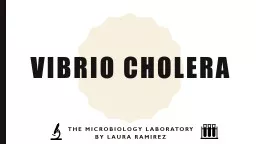

By Laura Ramirez Travelling in India Fulfilling a long held travel dream Robert has taken six months off work and is making his way through India taking in the sights experiencing local festivals and making time to get to know the people He is cautious in his hygiene eating and drinking habits ID: 777112
Download The PPT/PDF document "Vibrio cholera The Microbiology Laborato..." is the property of its rightful owner. Permission is granted to download and print the materials on this web site for personal, non-commercial use only, and to display it on your personal computer provided you do not modify the materials and that you retain all copyright notices contained in the materials. By downloading content from our website, you accept the terms of this agreement.
Slide1
Vibrio cholera
The Microbiology Laboratory By Laura Ramirez
Slide2Travelling in India
Fulfilling a long held travel dream, Robert has taken six months off work and is making his way through India taking in the sights, experiencing local festivals and making time to get to know the people. He is cautious in his hygiene, eating and drinking habits but despite this he contracts a diarrhea with voluminous outpouring of fluid accompanied by vomiting. He suspects cholera and with the help of a fellow traveler gets himself to a local hospital where a stool sample is examined and his presumptive diagnosis is confirmed. He stocks up on appropriate fluids and stays put at the hostel he has booked into for a few days, experiencing some minor leg cramping along with the diarrhea. His curiosity about his illness has him reading up on the organisms when he returns to North America and he is left wondering what serotype of Vibrio cholerae he might have contracted, should he have been prescribed antibiotics, was there anything more he could have done to prevent contracting the organism and might he now be a carrier?
Slide3Other
possible
bacterial pathogens associated with this type of infectious scenario in Asia and in North America?
Campylobacter
Symptoms: diarrhea, abdominal pain, fever, nausea, and vomiting
Route to infection: food route
Leading cause of foodborne disease in Southeast Asia and N. America
20 million cases in Asia in 2010, 1.3 million cases in N. America
Shigella
Symptoms:
tenesmus
, abdominal pain, watery diarrhea, fever, dehydration, dysentery and convulsions
Route to infection: food route
2nd most common food borne disease, 19 million cases, in Asia
500,000 cases annually in N. America
Slide4Other
possible
bacterial pathogens associated with this type of infectious scenario in Asia and in North America?
Escherichia coli
Symptom: stomach cramps, bloody diarrhea, vomiting and fever
Natural resident in the gut flora, generally harmless, must acquire mutations and produce Shiga toxin to be pathogenic
Asia: 3
rd
most common food borne diseases, 19 million cases, in 2010
265,000 cases in N. America, annually
Salmonella
Symptoms: diarrhea, abdominal cramps, fever and in severe cases, enteric fevers that require antibiotics
Route to infection: food
4 million cases in Asia in 2010
1.2 million cases annually, 450 deaths in N. America
Slide5diagnosis of V. cholera
Stool SamplePatient must follow dietary restrictions 72 hours before the sample is taken
Cannot be mixed with water or urine, or it might interfere with the analytical processMust be kept in a cool environment until transport to the lab. With a transport medium, it can preserve the sample for up to 4 weeksOnce in the isolation medium, sample should be left to incubate for 18-24 hours at 35 to 37°.Diagnosis requires the stool sample due to the many other possible pathogens that could be causing the same symptomsSome treatments against one pathogen, may enhance another pathogen
Slide6Laboratory testing for diagnosis of V. cholera
Slide7Laboratory Testing for diagnosis of V. cholera
Other tests
Oxidase test- drop oxidase reagents onto filter paper in a Petri dish, smear sample across the wet filter paper with an inoculating loop, if turns purple in 10 seconds, then it is positive.
String test- rules out possibility of
Aeromonas
species, V. cholera suspension from HIA medium is added with sodium deoxycholate, if it has mucous like texture, it is positive for V. cholera.
Gram stains- sample can be identified with crystal violet to observe the curved rod-like morphology
PCR- polymer chain reaction detects cholera toxins, test targets virulence genes or DNA sequence specific to the pathogen
Growing bacteria on other media:
Kliger
iron agar (KIA), triple sugar iron agar (TIA), Taurocholate-telluride gelatine agar (TTGA)
Slide8V. cholera Serotype Diagnosis
Slide Agglutination Test Confirms serotypeDone by taking a colony, streaking and incubating it onto a heart infusion agar or
tryptone soy agarLet grow for 6-24 hours Usually O1 and O139 are detected Serotype TestUse a drop of sterile saline on a clean glass slide, add a V. cholera suspension, add a small drop of antiserum specific to the O1 serotype and tilt back and forth to spread a solution
Agglutination in 30 -60 seconds confirms O1 serotype, if negative result these re-examine with O139 antisera
Slide9Expected Results
If using cultures
TTGA – colonies 1-2mm in diameter, translucent with black center
TCBS – colonies 2-3mm in diameter, yellow and shiny
MacConkey medium – colonies 1-3mm in diameter, colourless to pink
Not every strain of O1 is able to be cultured with this method
If using ELISA/FLISA & Immunocapture Agglutination Assay
ELISA- color change when bound to antigen-bound antibody
FLISA- fluorophore-tagged antibody emits light upon epitope-antigen binding
IAA- large clumps form due to antibodies cross-linking between antigens
PCR and Non-inhibitory Detection Methods
KIA and TIA- pink color
Decarboxylase/
dihydrolase
reactions- purple color if positive
PCR- amplifies regions specific to V. cholera, products are analyzed with gel electrophoresis and compared to known samples of V. cholera
.